Stroke Rehabilitation: Critical Appraisal of Patient and Carer Needs
VerifiedAdded on 2023/06/11
|8
|1760
|73
Report
AI Summary
This report provides a critical appraisal of a journal article concerning stroke rehabilitation needs, particularly focusing on a clinical scenario involving a 67-year-old woman whose rehabilitation needs were unmet post-discharge. The appraisal examines the authorship, research questions, design, methodology, and results of the study, highlighting both strengths and limitations. It emphasizes the importance of mixed-methods research in understanding patient and caregiver perceptions of rehabilitation needs one year post-stroke. The report also addresses barriers to applying evidence-based practice in stroke rehabilitation, including organizational and individual challenges such as reluctance to adopt new research, difficulties in policy development, and negative perceptions among clinicians. The conclusion underscores the need for addressing these barriers to improve patient outcomes and ensure that rehabilitation practices are informed by credible, evidence-based research. Desklib offers a wealth of similar resources, including past papers and solved assignments, to aid students in their studies.
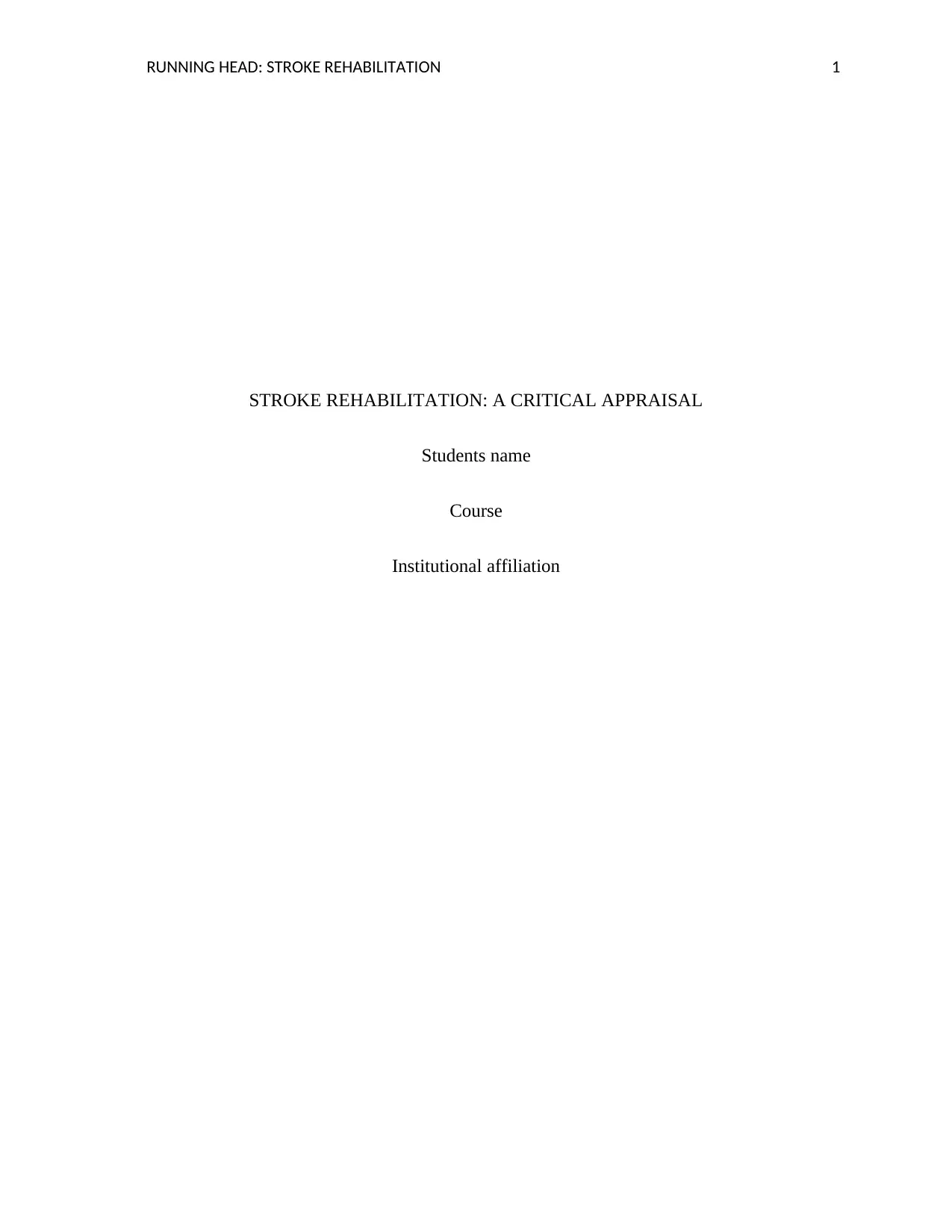
RUNNING HEAD: STROKE REHABILITATION 1
STROKE REHABILITATION: A CRITICAL APPRAISAL
Students name
Course
Institutional affiliation
STROKE REHABILITATION: A CRITICAL APPRAISAL
Students name
Course
Institutional affiliation
Paraphrase This Document
Need a fresh take? Get an instant paraphrase of this document with our AI Paraphraser
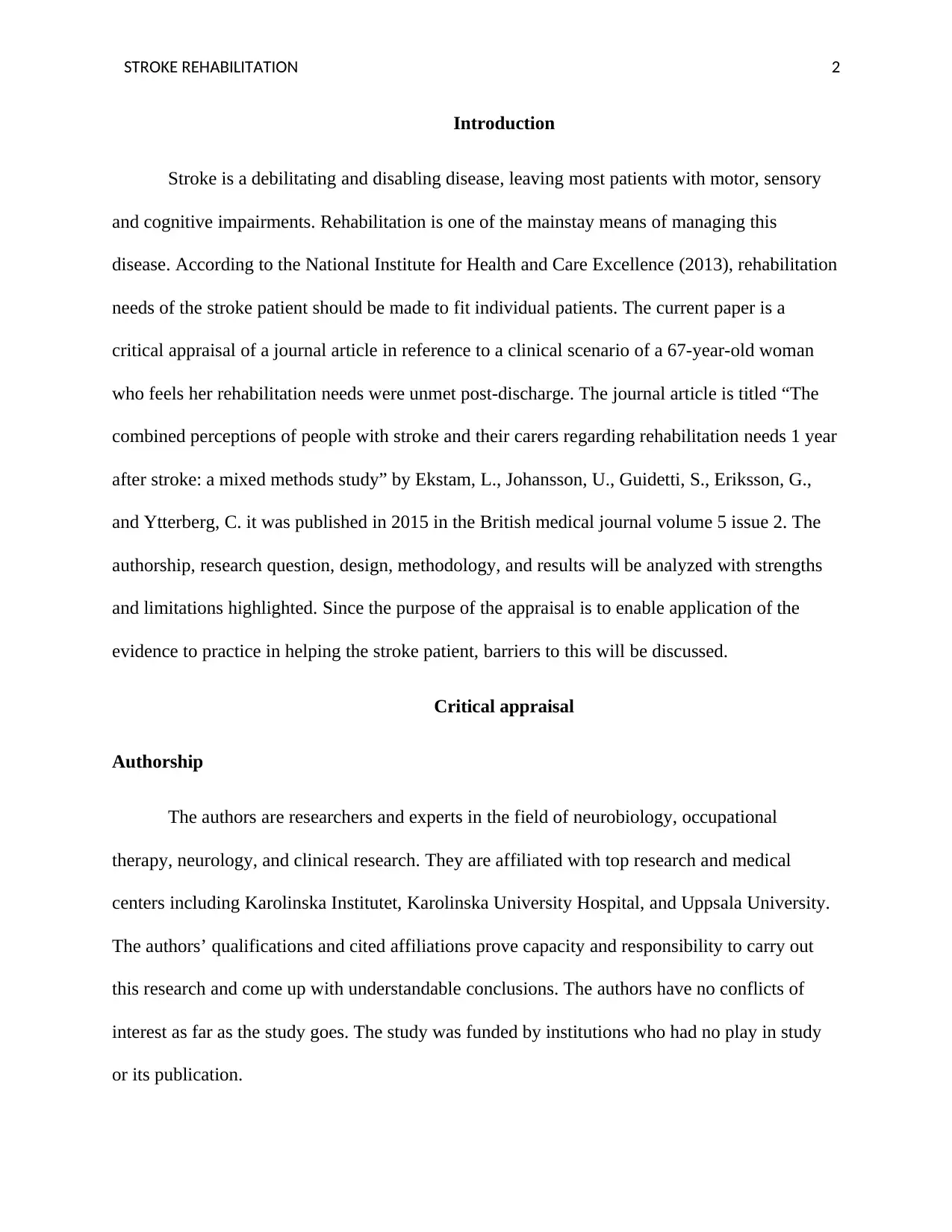
STROKE REHABILITATION 2
Introduction
Stroke is a debilitating and disabling disease, leaving most patients with motor, sensory
and cognitive impairments. Rehabilitation is one of the mainstay means of managing this
disease. According to the National Institute for Health and Care Excellence (2013), rehabilitation
needs of the stroke patient should be made to fit individual patients. The current paper is a
critical appraisal of a journal article in reference to a clinical scenario of a 67-year-old woman
who feels her rehabilitation needs were unmet post-discharge. The journal article is titled “The
combined perceptions of people with stroke and their carers regarding rehabilitation needs 1 year
after stroke: a mixed methods study” by Ekstam, L., Johansson, U., Guidetti, S., Eriksson, G.,
and Ytterberg, C. it was published in 2015 in the British medical journal volume 5 issue 2. The
authorship, research question, design, methodology, and results will be analyzed with strengths
and limitations highlighted. Since the purpose of the appraisal is to enable application of the
evidence to practice in helping the stroke patient, barriers to this will be discussed.
Critical appraisal
Authorship
The authors are researchers and experts in the field of neurobiology, occupational
therapy, neurology, and clinical research. They are affiliated with top research and medical
centers including Karolinska Institutet, Karolinska University Hospital, and Uppsala University.
The authors’ qualifications and cited affiliations prove capacity and responsibility to carry out
this research and come up with understandable conclusions. The authors have no conflicts of
interest as far as the study goes. The study was funded by institutions who had no play in study
or its publication.
Introduction
Stroke is a debilitating and disabling disease, leaving most patients with motor, sensory
and cognitive impairments. Rehabilitation is one of the mainstay means of managing this
disease. According to the National Institute for Health and Care Excellence (2013), rehabilitation
needs of the stroke patient should be made to fit individual patients. The current paper is a
critical appraisal of a journal article in reference to a clinical scenario of a 67-year-old woman
who feels her rehabilitation needs were unmet post-discharge. The journal article is titled “The
combined perceptions of people with stroke and their carers regarding rehabilitation needs 1 year
after stroke: a mixed methods study” by Ekstam, L., Johansson, U., Guidetti, S., Eriksson, G.,
and Ytterberg, C. it was published in 2015 in the British medical journal volume 5 issue 2. The
authorship, research question, design, methodology, and results will be analyzed with strengths
and limitations highlighted. Since the purpose of the appraisal is to enable application of the
evidence to practice in helping the stroke patient, barriers to this will be discussed.
Critical appraisal
Authorship
The authors are researchers and experts in the field of neurobiology, occupational
therapy, neurology, and clinical research. They are affiliated with top research and medical
centers including Karolinska Institutet, Karolinska University Hospital, and Uppsala University.
The authors’ qualifications and cited affiliations prove capacity and responsibility to carry out
this research and come up with understandable conclusions. The authors have no conflicts of
interest as far as the study goes. The study was funded by institutions who had no play in study
or its publication.
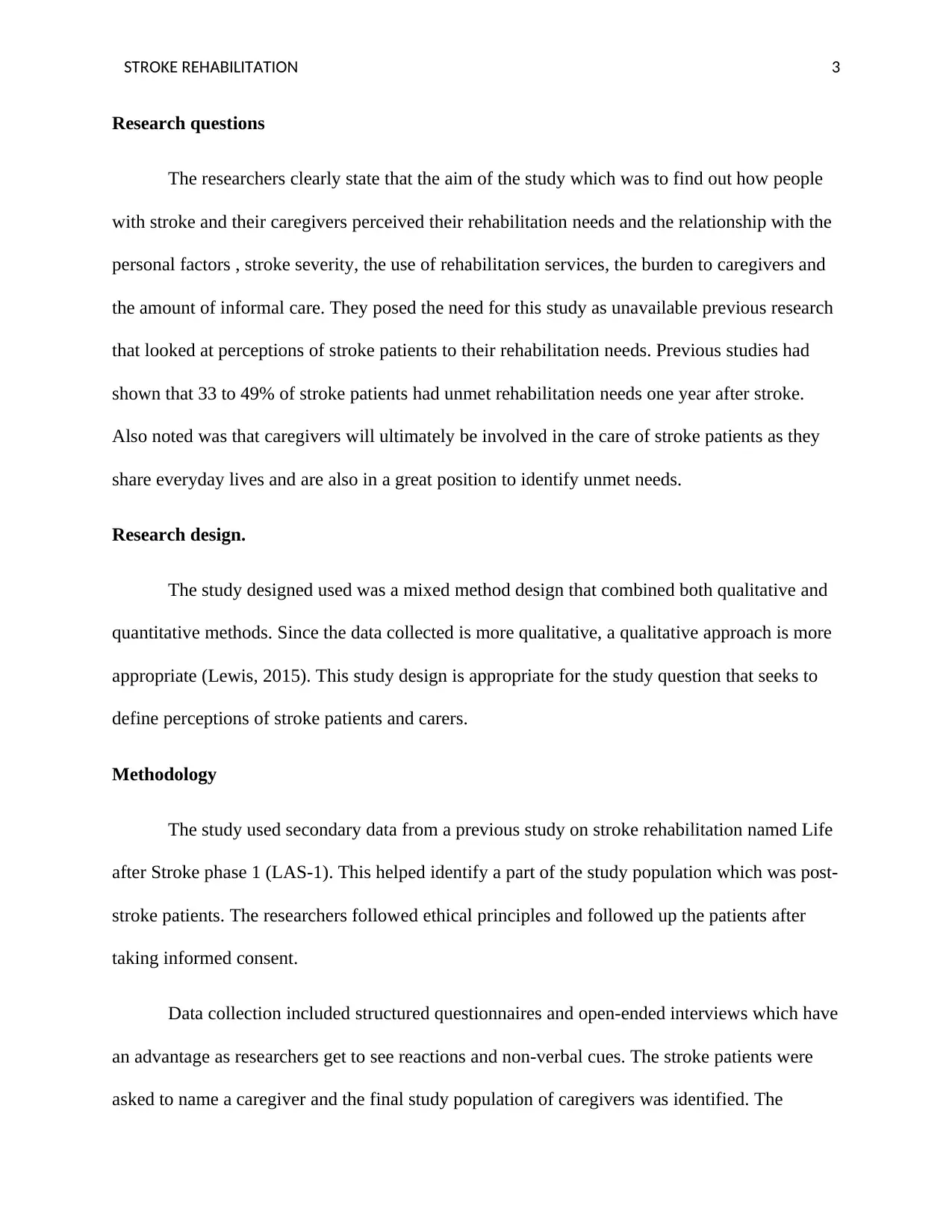
STROKE REHABILITATION 3
Research questions
The researchers clearly state that the aim of the study which was to find out how people
with stroke and their caregivers perceived their rehabilitation needs and the relationship with the
personal factors , stroke severity, the use of rehabilitation services, the burden to caregivers and
the amount of informal care. They posed the need for this study as unavailable previous research
that looked at perceptions of stroke patients to their rehabilitation needs. Previous studies had
shown that 33 to 49% of stroke patients had unmet rehabilitation needs one year after stroke.
Also noted was that caregivers will ultimately be involved in the care of stroke patients as they
share everyday lives and are also in a great position to identify unmet needs.
Research design.
The study designed used was a mixed method design that combined both qualitative and
quantitative methods. Since the data collected is more qualitative, a qualitative approach is more
appropriate (Lewis, 2015). This study design is appropriate for the study question that seeks to
define perceptions of stroke patients and carers.
Methodology
The study used secondary data from a previous study on stroke rehabilitation named Life
after Stroke phase 1 (LAS-1). This helped identify a part of the study population which was post-
stroke patients. The researchers followed ethical principles and followed up the patients after
taking informed consent.
Data collection included structured questionnaires and open-ended interviews which have
an advantage as researchers get to see reactions and non-verbal cues. The stroke patients were
asked to name a caregiver and the final study population of caregivers was identified. The
Research questions
The researchers clearly state that the aim of the study which was to find out how people
with stroke and their caregivers perceived their rehabilitation needs and the relationship with the
personal factors , stroke severity, the use of rehabilitation services, the burden to caregivers and
the amount of informal care. They posed the need for this study as unavailable previous research
that looked at perceptions of stroke patients to their rehabilitation needs. Previous studies had
shown that 33 to 49% of stroke patients had unmet rehabilitation needs one year after stroke.
Also noted was that caregivers will ultimately be involved in the care of stroke patients as they
share everyday lives and are also in a great position to identify unmet needs.
Research design.
The study designed used was a mixed method design that combined both qualitative and
quantitative methods. Since the data collected is more qualitative, a qualitative approach is more
appropriate (Lewis, 2015). This study design is appropriate for the study question that seeks to
define perceptions of stroke patients and carers.
Methodology
The study used secondary data from a previous study on stroke rehabilitation named Life
after Stroke phase 1 (LAS-1). This helped identify a part of the study population which was post-
stroke patients. The researchers followed ethical principles and followed up the patients after
taking informed consent.
Data collection included structured questionnaires and open-ended interviews which have
an advantage as researchers get to see reactions and non-verbal cues. The stroke patients were
asked to name a caregiver and the final study population of caregivers was identified. The
⊘ This is a preview!⊘
Do you want full access?
Subscribe today to unlock all pages.

Trusted by 1+ million students worldwide
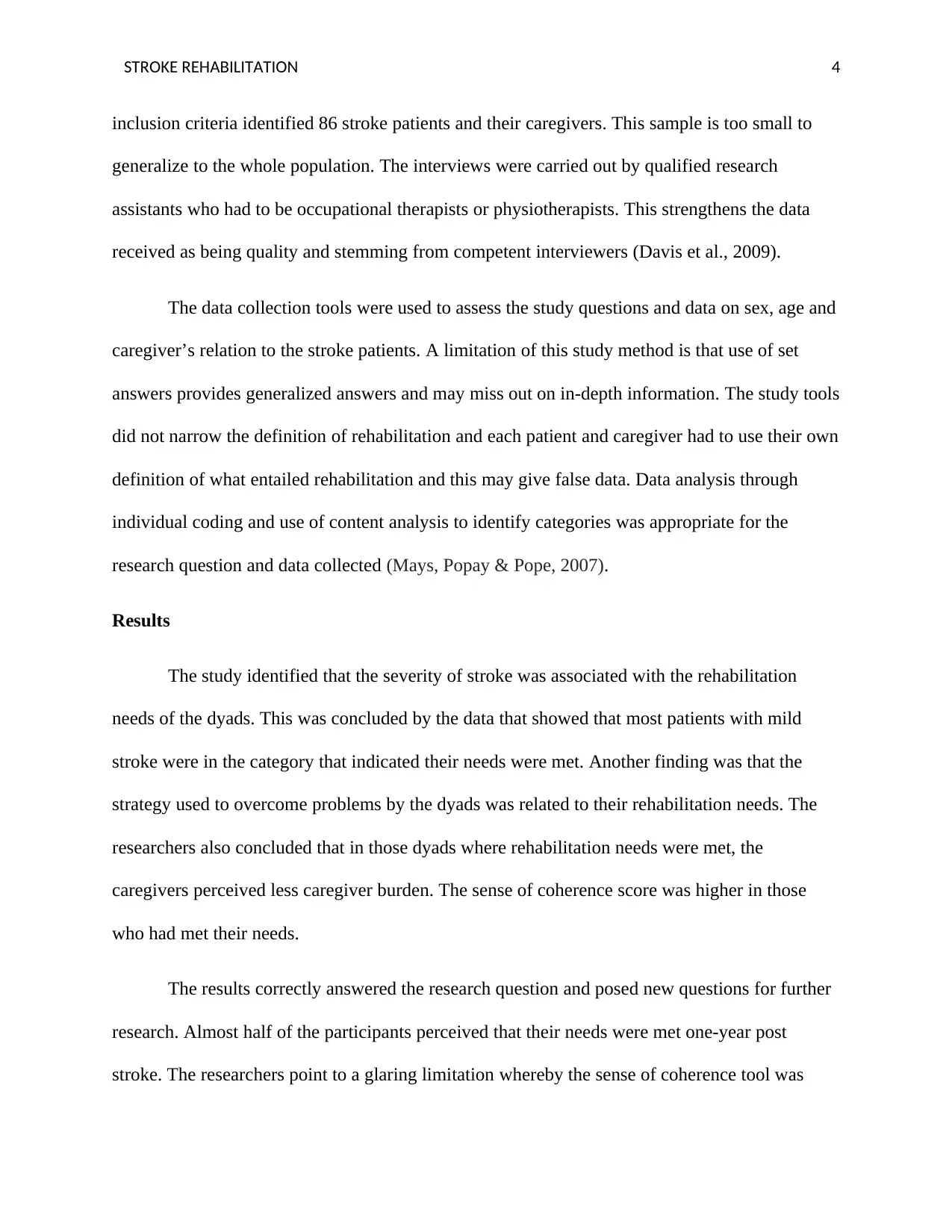
STROKE REHABILITATION 4
inclusion criteria identified 86 stroke patients and their caregivers. This sample is too small to
generalize to the whole population. The interviews were carried out by qualified research
assistants who had to be occupational therapists or physiotherapists. This strengthens the data
received as being quality and stemming from competent interviewers (Davis et al., 2009).
The data collection tools were used to assess the study questions and data on sex, age and
caregiver’s relation to the stroke patients. A limitation of this study method is that use of set
answers provides generalized answers and may miss out on in-depth information. The study tools
did not narrow the definition of rehabilitation and each patient and caregiver had to use their own
definition of what entailed rehabilitation and this may give false data. Data analysis through
individual coding and use of content analysis to identify categories was appropriate for the
research question and data collected (Mays, Popay & Pope, 2007).
Results
The study identified that the severity of stroke was associated with the rehabilitation
needs of the dyads. This was concluded by the data that showed that most patients with mild
stroke were in the category that indicated their needs were met. Another finding was that the
strategy used to overcome problems by the dyads was related to their rehabilitation needs. The
researchers also concluded that in those dyads where rehabilitation needs were met, the
caregivers perceived less caregiver burden. The sense of coherence score was higher in those
who had met their needs.
The results correctly answered the research question and posed new questions for further
research. Almost half of the participants perceived that their needs were met one-year post
stroke. The researchers point to a glaring limitation whereby the sense of coherence tool was
inclusion criteria identified 86 stroke patients and their caregivers. This sample is too small to
generalize to the whole population. The interviews were carried out by qualified research
assistants who had to be occupational therapists or physiotherapists. This strengthens the data
received as being quality and stemming from competent interviewers (Davis et al., 2009).
The data collection tools were used to assess the study questions and data on sex, age and
caregiver’s relation to the stroke patients. A limitation of this study method is that use of set
answers provides generalized answers and may miss out on in-depth information. The study tools
did not narrow the definition of rehabilitation and each patient and caregiver had to use their own
definition of what entailed rehabilitation and this may give false data. Data analysis through
individual coding and use of content analysis to identify categories was appropriate for the
research question and data collected (Mays, Popay & Pope, 2007).
Results
The study identified that the severity of stroke was associated with the rehabilitation
needs of the dyads. This was concluded by the data that showed that most patients with mild
stroke were in the category that indicated their needs were met. Another finding was that the
strategy used to overcome problems by the dyads was related to their rehabilitation needs. The
researchers also concluded that in those dyads where rehabilitation needs were met, the
caregivers perceived less caregiver burden. The sense of coherence score was higher in those
who had met their needs.
The results correctly answered the research question and posed new questions for further
research. Almost half of the participants perceived that their needs were met one-year post
stroke. The researchers point to a glaring limitation whereby the sense of coherence tool was
Paraphrase This Document
Need a fresh take? Get an instant paraphrase of this document with our AI Paraphraser
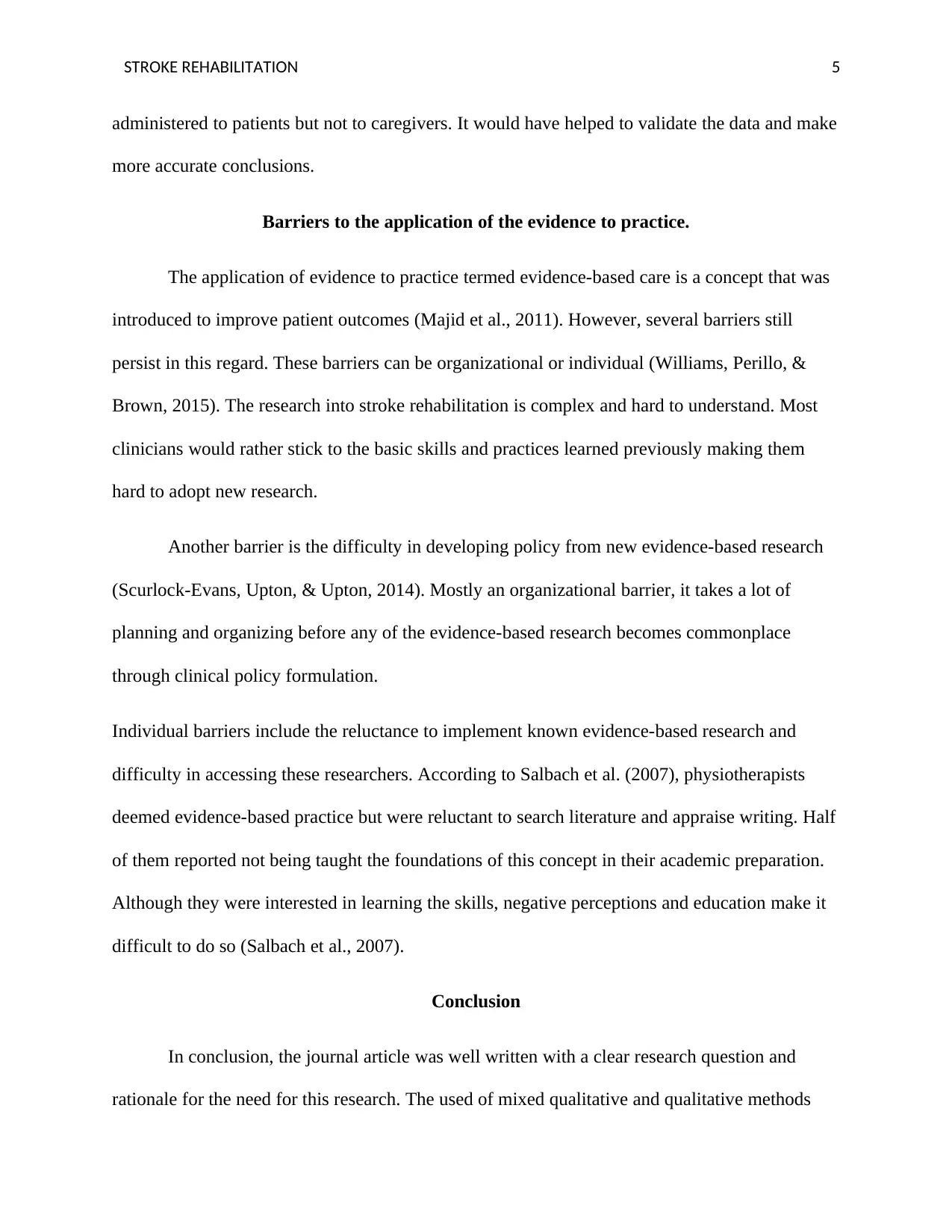
STROKE REHABILITATION 5
administered to patients but not to caregivers. It would have helped to validate the data and make
more accurate conclusions.
Barriers to the application of the evidence to practice.
The application of evidence to practice termed evidence-based care is a concept that was
introduced to improve patient outcomes (Majid et al., 2011). However, several barriers still
persist in this regard. These barriers can be organizational or individual (Williams, Perillo, &
Brown, 2015). The research into stroke rehabilitation is complex and hard to understand. Most
clinicians would rather stick to the basic skills and practices learned previously making them
hard to adopt new research.
Another barrier is the difficulty in developing policy from new evidence-based research
(Scurlock-Evans, Upton, & Upton, 2014). Mostly an organizational barrier, it takes a lot of
planning and organizing before any of the evidence-based research becomes commonplace
through clinical policy formulation.
Individual barriers include the reluctance to implement known evidence-based research and
difficulty in accessing these researchers. According to Salbach et al. (2007), physiotherapists
deemed evidence-based practice but were reluctant to search literature and appraise writing. Half
of them reported not being taught the foundations of this concept in their academic preparation.
Although they were interested in learning the skills, negative perceptions and education make it
difficult to do so (Salbach et al., 2007).
Conclusion
In conclusion, the journal article was well written with a clear research question and
rationale for the need for this research. The used of mixed qualitative and qualitative methods
administered to patients but not to caregivers. It would have helped to validate the data and make
more accurate conclusions.
Barriers to the application of the evidence to practice.
The application of evidence to practice termed evidence-based care is a concept that was
introduced to improve patient outcomes (Majid et al., 2011). However, several barriers still
persist in this regard. These barriers can be organizational or individual (Williams, Perillo, &
Brown, 2015). The research into stroke rehabilitation is complex and hard to understand. Most
clinicians would rather stick to the basic skills and practices learned previously making them
hard to adopt new research.
Another barrier is the difficulty in developing policy from new evidence-based research
(Scurlock-Evans, Upton, & Upton, 2014). Mostly an organizational barrier, it takes a lot of
planning and organizing before any of the evidence-based research becomes commonplace
through clinical policy formulation.
Individual barriers include the reluctance to implement known evidence-based research and
difficulty in accessing these researchers. According to Salbach et al. (2007), physiotherapists
deemed evidence-based practice but were reluctant to search literature and appraise writing. Half
of them reported not being taught the foundations of this concept in their academic preparation.
Although they were interested in learning the skills, negative perceptions and education make it
difficult to do so (Salbach et al., 2007).
Conclusion
In conclusion, the journal article was well written with a clear research question and
rationale for the need for this research. The used of mixed qualitative and qualitative methods
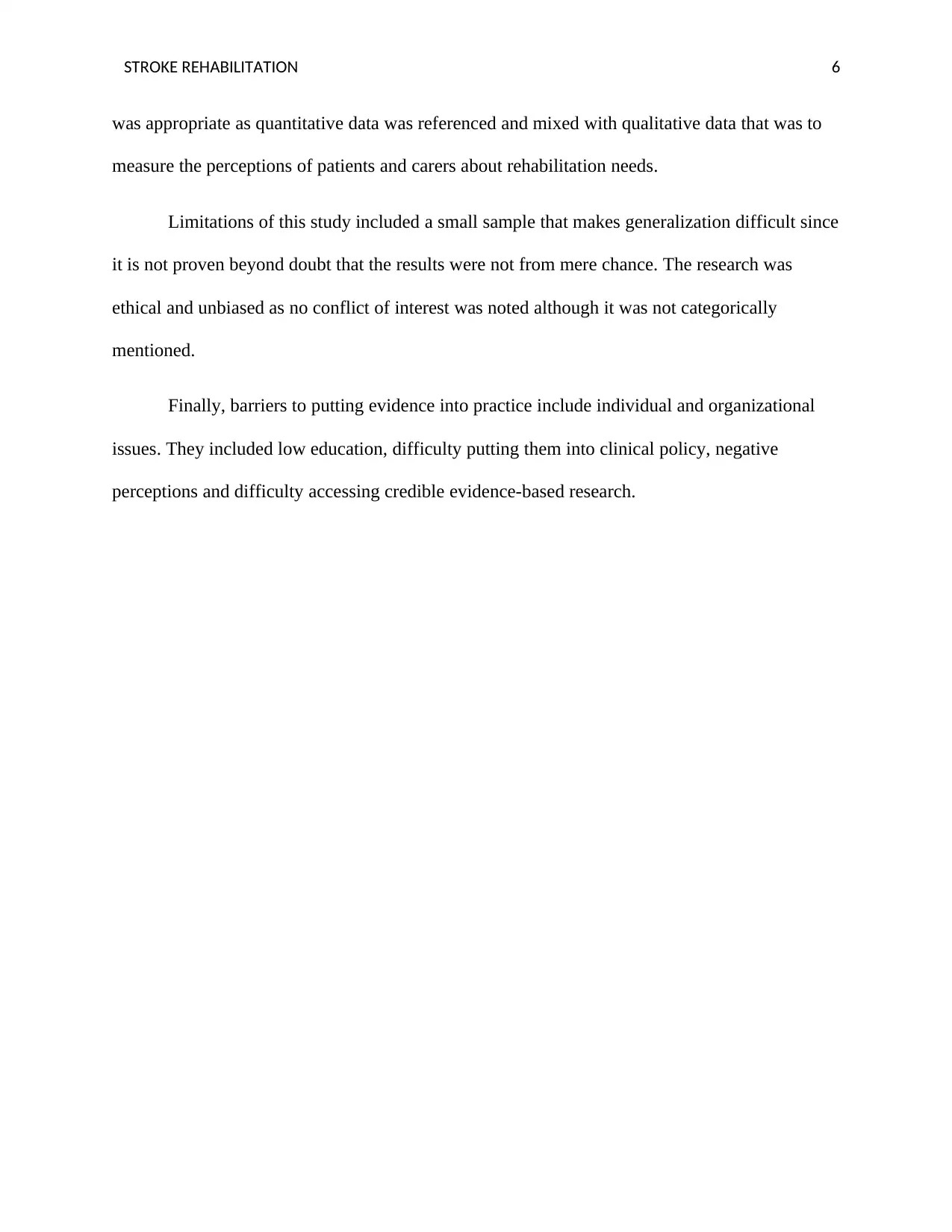
STROKE REHABILITATION 6
was appropriate as quantitative data was referenced and mixed with qualitative data that was to
measure the perceptions of patients and carers about rehabilitation needs.
Limitations of this study included a small sample that makes generalization difficult since
it is not proven beyond doubt that the results were not from mere chance. The research was
ethical and unbiased as no conflict of interest was noted although it was not categorically
mentioned.
Finally, barriers to putting evidence into practice include individual and organizational
issues. They included low education, difficulty putting them into clinical policy, negative
perceptions and difficulty accessing credible evidence-based research.
was appropriate as quantitative data was referenced and mixed with qualitative data that was to
measure the perceptions of patients and carers about rehabilitation needs.
Limitations of this study included a small sample that makes generalization difficult since
it is not proven beyond doubt that the results were not from mere chance. The research was
ethical and unbiased as no conflict of interest was noted although it was not categorically
mentioned.
Finally, barriers to putting evidence into practice include individual and organizational
issues. They included low education, difficulty putting them into clinical policy, negative
perceptions and difficulty accessing credible evidence-based research.
⊘ This is a preview!⊘
Do you want full access?
Subscribe today to unlock all pages.

Trusted by 1+ million students worldwide
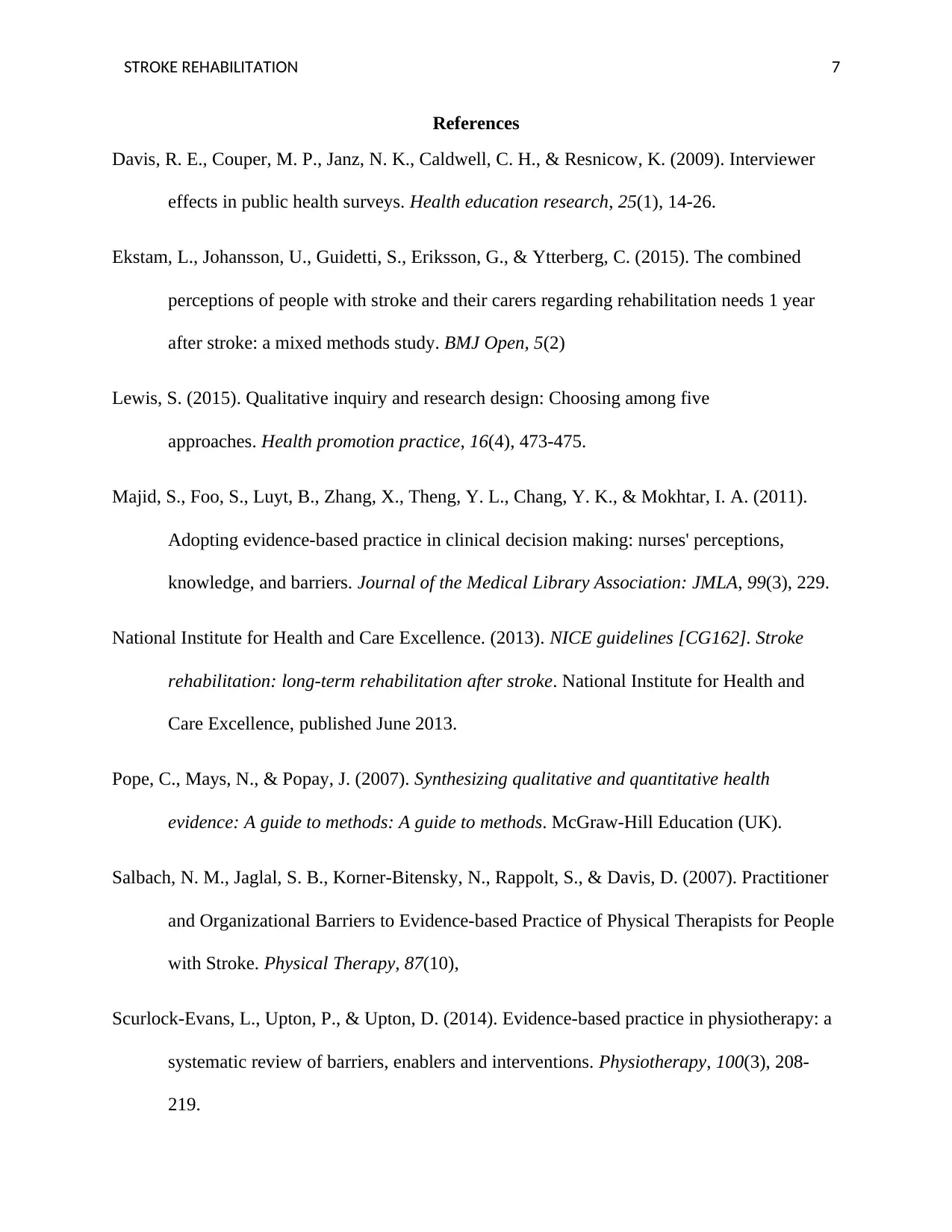
STROKE REHABILITATION 7
References
Davis, R. E., Couper, M. P., Janz, N. K., Caldwell, C. H., & Resnicow, K. (2009). Interviewer
effects in public health surveys. Health education research, 25(1), 14-26.
Ekstam, L., Johansson, U., Guidetti, S., Eriksson, G., & Ytterberg, C. (2015). The combined
perceptions of people with stroke and their carers regarding rehabilitation needs 1 year
after stroke: a mixed methods study. BMJ Open, 5(2)
Lewis, S. (2015). Qualitative inquiry and research design: Choosing among five
approaches. Health promotion practice, 16(4), 473-475.
Majid, S., Foo, S., Luyt, B., Zhang, X., Theng, Y. L., Chang, Y. K., & Mokhtar, I. A. (2011).
Adopting evidence-based practice in clinical decision making: nurses' perceptions,
knowledge, and barriers. Journal of the Medical Library Association: JMLA, 99(3), 229.
National Institute for Health and Care Excellence. (2013). NICE guidelines [CG162]. Stroke
rehabilitation: long-term rehabilitation after stroke. National Institute for Health and
Care Excellence, published June 2013.
Pope, C., Mays, N., & Popay, J. (2007). Synthesizing qualitative and quantitative health
evidence: A guide to methods: A guide to methods. McGraw-Hill Education (UK).
Salbach, N. M., Jaglal, S. B., Korner-Bitensky, N., Rappolt, S., & Davis, D. (2007). Practitioner
and Organizational Barriers to Evidence-based Practice of Physical Therapists for People
with Stroke. Physical Therapy, 87(10),
Scurlock-Evans, L., Upton, P., & Upton, D. (2014). Evidence-based practice in physiotherapy: a
systematic review of barriers, enablers and interventions. Physiotherapy, 100(3), 208-
219.
References
Davis, R. E., Couper, M. P., Janz, N. K., Caldwell, C. H., & Resnicow, K. (2009). Interviewer
effects in public health surveys. Health education research, 25(1), 14-26.
Ekstam, L., Johansson, U., Guidetti, S., Eriksson, G., & Ytterberg, C. (2015). The combined
perceptions of people with stroke and their carers regarding rehabilitation needs 1 year
after stroke: a mixed methods study. BMJ Open, 5(2)
Lewis, S. (2015). Qualitative inquiry and research design: Choosing among five
approaches. Health promotion practice, 16(4), 473-475.
Majid, S., Foo, S., Luyt, B., Zhang, X., Theng, Y. L., Chang, Y. K., & Mokhtar, I. A. (2011).
Adopting evidence-based practice in clinical decision making: nurses' perceptions,
knowledge, and barriers. Journal of the Medical Library Association: JMLA, 99(3), 229.
National Institute for Health and Care Excellence. (2013). NICE guidelines [CG162]. Stroke
rehabilitation: long-term rehabilitation after stroke. National Institute for Health and
Care Excellence, published June 2013.
Pope, C., Mays, N., & Popay, J. (2007). Synthesizing qualitative and quantitative health
evidence: A guide to methods: A guide to methods. McGraw-Hill Education (UK).
Salbach, N. M., Jaglal, S. B., Korner-Bitensky, N., Rappolt, S., & Davis, D. (2007). Practitioner
and Organizational Barriers to Evidence-based Practice of Physical Therapists for People
with Stroke. Physical Therapy, 87(10),
Scurlock-Evans, L., Upton, P., & Upton, D. (2014). Evidence-based practice in physiotherapy: a
systematic review of barriers, enablers and interventions. Physiotherapy, 100(3), 208-
219.
Paraphrase This Document
Need a fresh take? Get an instant paraphrase of this document with our AI Paraphraser
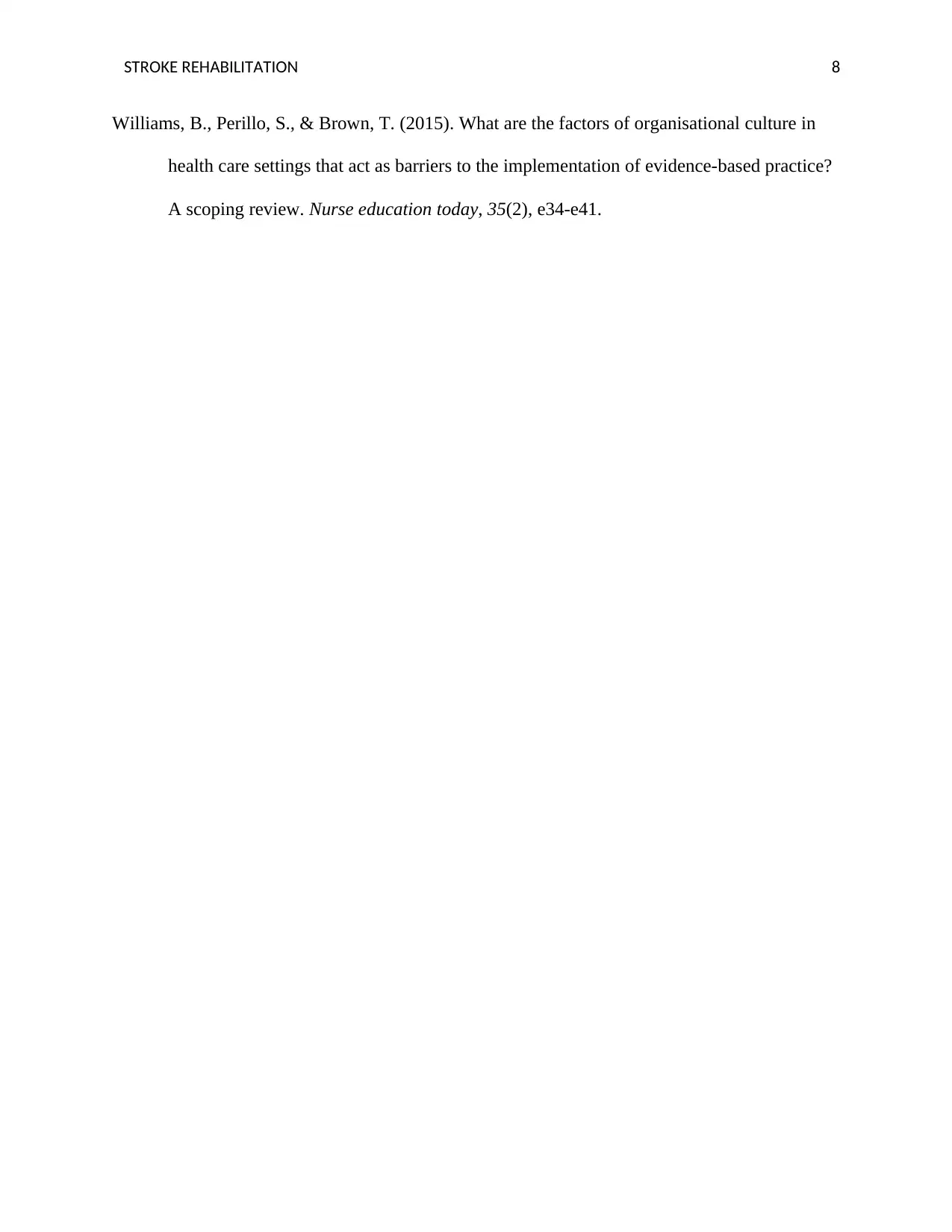
STROKE REHABILITATION 8
Williams, B., Perillo, S., & Brown, T. (2015). What are the factors of organisational culture in
health care settings that act as barriers to the implementation of evidence-based practice?
A scoping review. Nurse education today, 35(2), e34-e41.
Williams, B., Perillo, S., & Brown, T. (2015). What are the factors of organisational culture in
health care settings that act as barriers to the implementation of evidence-based practice?
A scoping review. Nurse education today, 35(2), e34-e41.
1 out of 8
Related Documents
Your All-in-One AI-Powered Toolkit for Academic Success.
+13062052269
info@desklib.com
Available 24*7 on WhatsApp / Email
![[object Object]](/_next/static/media/star-bottom.7253800d.svg)
Unlock your academic potential
Copyright © 2020–2025 A2Z Services. All Rights Reserved. Developed and managed by ZUCOL.




